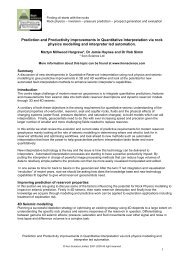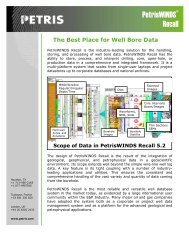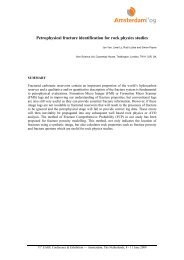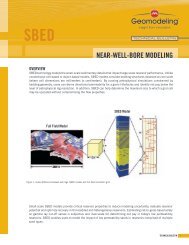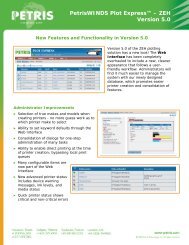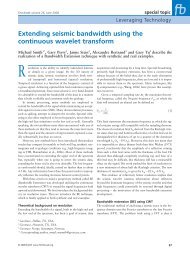Titles should be in Arial font size 12 bold - Net Brains
Titles should be in Arial font size 12 bold - Net Brains
Titles should be in Arial font size 12 bold - Net Brains
You also want an ePaper? Increase the reach of your titles
YUMPU automatically turns print PDFs into web optimized ePapers that Google loves.
F<strong>in</strong>d<strong>in</strong>g<br />
F<strong>in</strong>d<strong>in</strong>g oil starts with the rocks<br />
Rock physics – <strong>in</strong>version – pressure prediction – prospect generation and evaluation<br />
The Brenda Field Development: a Multi-Discipl<strong>in</strong>ary Approach<br />
Ian F. Jones, Rod Christensen, Jamie Haynes, John Faragher, Ika Novianti,<br />
Henry Morris * and Giles Picker<strong>in</strong>g<br />
* Ikon Science Ltd<br />
More <strong>in</strong>formation about this topic can <strong>be</strong> found at www.ikonscience.com<br />
Abstract<br />
Recent <strong>in</strong>itiatives <strong>in</strong> the North Sea and UKCS such as the <strong>in</strong>troduction of the „Fallow Field‟ <strong>in</strong>itiative and<br />
offer<strong>in</strong>g of „Promote‟ licenses have started to generate activity by attract<strong>in</strong>g new entrants who can provide<br />
new capital and new ideas to focus on exploration and appraisal. Fields which had <strong>be</strong>en abandoned, or<br />
considered of <strong>in</strong>sufficient commercial <strong>in</strong>terest have <strong>be</strong>en offered a new lease of life by allow<strong>in</strong>g proactive<br />
companies to identify and exploit latent commercial prospects by ty<strong>in</strong>g <strong>in</strong> to exist<strong>in</strong>g <strong>in</strong>frastructure.<br />
Here we showcase one such recent discovery, made by Oilexco, where a multi-discipl<strong>in</strong>ary approach was<br />
taken to identify potential targets us<strong>in</strong>g state-of-the-art pre-process<strong>in</strong>g and high resolution velocity model<br />
build<strong>in</strong>g and pre-stack imag<strong>in</strong>g, comb<strong>in</strong>ed with detailed calibrated reservoir attribute analysis based on<br />
elastic impedance <strong>in</strong>version.<br />
This field could prove to <strong>be</strong> one of the largest f<strong>in</strong>ds <strong>in</strong> the North Sea <strong>in</strong> recent years.<br />
Introduction<br />
Oilexco's UK North Sea drill<strong>in</strong>g program on License P1042 (Block 15/25b) <strong>in</strong> the Outer Moray Firth, targeted<br />
oil <strong>in</strong> the Palaeocene Upper Balmoral Sandstone. Initially three wells were proposed:, one on the structure<br />
previously drilled by the 15/25b-3 well, one on a structural high with classic four-way closure and one on a<br />
channel sand feature, whose prospectivity was <strong>in</strong>dicated by an anomalously low elastic impedance (EI)<br />
response on the far-offset stack.<br />
The surface location of the first new well, 15/25b-6 is approximately 150 meters west of Conoco‟s 15/25b-3<br />
undeveloped discovery, which tested 2,690 bbl/d of 39 degrees oil from the Upper Balmoral Sandstone from<br />
20 feet of net pay <strong>in</strong> 1990.<br />
The 15/25b-6 well encountered the "Brenda" oil f<strong>in</strong>d announced by Oilexco on January 26 2004. The well<br />
<strong>in</strong>tersected a series of oil-<strong>be</strong>ar<strong>in</strong>g Palaeocene Upper Balmoral sands, the thickest of which has 26 feet of<br />
high quality oil pay. In addition to this sand, several other th<strong>in</strong> <strong>be</strong>dded oil <strong>be</strong>ar<strong>in</strong>g sands were also<br />
<strong>in</strong>tersected. The entire section was tested and yielded 40 degrees API oil from the Upper Balmoral<br />
Sandstone at an average rate of 2,980 bbl/d, over an 18-hour test under stable flow<strong>in</strong>g conditions, from 56<br />
feet of perforations (evaluated with open-hole wire-l<strong>in</strong>e logs and formation fluid sampl<strong>in</strong>g tools). Associated<br />
natural gas flowed at an average rate of 600 Mcf/d throughout the test. No water or sand was produced<br />
dur<strong>in</strong>g the test period.<br />
The surface location of the second well (15/25b-7) is approximately 4 kilometres northwest of 15/25b-6.. The<br />
vertical hole encountered ~ 50 feet of good quality Upper Balmoral sand which was logged as water <strong>be</strong>ar<strong>in</strong>g.<br />
The side-track (15/25b-7Z) encountered another very porous clean Palaeocene Upper Balmoral sand with a<br />
th<strong>in</strong> oil column at the top of the sand and a mud log gas response. The results of the well suggest that the<br />
"Sheryl" structure is separate from the "Brenda" oil accumulation which is at a structurally lower position. As<br />
a consequence, the well was abandoned<br />
The third well, (15/25b-8) targeted the low EI anomaly. It was located 0.50 kilometres west of the 15/25b-6<br />
well, act<strong>in</strong>g as an appraisal well to the "Brenda" oil accumulation. The well encountered 69ft of high quality<br />
oil pay <strong>in</strong> the Upper Balmoral sand, and also tested 40 degree API oil, but at rates up to 4785 bbl/d.<br />
The Brenda Field Development: a Multi-Discipl<strong>in</strong>ary Approach<br />
© Ikon Science Limited, 2001-2009 All right reserved<br />
1
F<strong>in</strong>d<strong>in</strong>g<br />
F<strong>in</strong>d<strong>in</strong>g oil starts with the rocks<br />
Rock physics – <strong>in</strong>version – pressure prediction – prospect generation and evaluation<br />
Geological Sett<strong>in</strong>g and Drill<strong>in</strong>g Program<br />
Dur<strong>in</strong>g the Palaeocene, the East Shetland and Orkney Platforms were sites of deltaic outbuild<strong>in</strong>g. These<br />
platforms were uplifted by significant thermal bulg<strong>in</strong>g. The uplift<strong>in</strong>g and over-steepen<strong>in</strong>g of the delta and<br />
shelf slope systems caused <strong>in</strong>stability and failure result<strong>in</strong>g <strong>in</strong> a direct supply of sands and sediments to the<br />
bas<strong>in</strong> with<strong>in</strong> density flows. Conf<strong>in</strong>ed density flows of sand-rich sediment started with erosional scour<br />
channels that were not overwhelmed by the volume of sediment supply. These dist<strong>in</strong>ct channel fairways<br />
mark the sand transport paths. Sands with<strong>in</strong> these meander<strong>in</strong>g channels are characterized as massive<br />
sandstones with planar and lam<strong>in</strong>ated sandstones and occasional load and dish structures. This type of<br />
density flow is common <strong>in</strong> the later Palaeocene (Thanetian) and can generally <strong>be</strong> recognized by seismic data<br />
due to the contrast <strong>be</strong>tween the laterally equivalent shales and claystones.<br />
Initially, Oilexco reported that the uppermost Paleocene sand was the Forties Mem<strong>be</strong>r of the Rogaland<br />
Group, however, subsequent biostratigraphic analysis has placed this sand with<strong>in</strong> the Upper Balmoral<br />
Mem<strong>be</strong>r of the Montrose Group.<br />
The depositional profile was demonstrated <strong>in</strong> a Conoco core display at the 2003 Petroleum Geology<br />
Conference, which utilized the 15/<strong>12</strong>-1 well as illustrative of the shelf. The Balmoral-age sands were<br />
deposited <strong>in</strong> a sand (wave dom<strong>in</strong>ated) delta with clean, w<strong>in</strong>nowed sand build<strong>in</strong>g up dur<strong>in</strong>g a highstand. As<br />
the delta front was oversteepened, periodic failure occurred which triggered debris flows that traveled up to<br />
25 kilometres. This provided the sand reservoirs at MacCulloch and <strong>be</strong>yond (figure 1). The cores from the<br />
Conoco MacCulloch wells are <strong>in</strong>dicative of sand-rich debris/density flows, similar to the sands Oilexco is<br />
see<strong>in</strong>g with<strong>in</strong> the Upper Balmoral Mem<strong>be</strong>r <strong>in</strong> the 15/25b Block. Some of these sand types are descri<strong>be</strong>d, by<br />
Conoco, as upper medium-gra<strong>in</strong>ed, feldspathic, massive sandstone with very rare fa<strong>in</strong>t lam<strong>in</strong>ations, oilsaturated,<br />
friable to uncemented, very high porosity estimated to 30%, permeability measured from 1 to 2<br />
Darcies.<br />
Oilexco <strong>in</strong>terpreted that the Palaeocene Upper Balmoral “density flow” sand was only partially encountered<br />
by the Conoco 15/25b-3 well. The channel was nearly 50 feet thick at the nearby Sun Glamis 16/21a-6 well.<br />
In the other direction, the 15/24b-6 well <strong>in</strong> the down-dip portion of the MacCulloch Field conta<strong>in</strong>s over <strong>12</strong>0<br />
feet of the Upper Balmoral Sandstone Mem<strong>be</strong>r. The 15/25b-3 well encountered only 22 feet of sand. This<br />
sand was f<strong>in</strong>e to medium gra<strong>in</strong>ed, moderately sorted, and friable. The sedimentary structures of this sand<br />
were massive with planar lam<strong>in</strong>ations and good visible porosity. The entire sand down to the scour was oil<br />
sta<strong>in</strong>ed with uniform yellow fluorescence and fast stream<strong>in</strong>g cut. Core exam<strong>in</strong>ation of the Conoco 15/25b-3<br />
well allowed Oilexco to question whether or not the oil was trapped structurally or stratigraphically. An<br />
oil/water contact was not evident <strong>in</strong> the Upper Balmoral sand <strong>in</strong> this core and a possible stratigraphic<br />
trapp<strong>in</strong>g mechanism was suspected.<br />
The Oilexco 15/25b-6 well location was selected to test the stratigraphic <strong>in</strong>terpretation of the Upper Balmoral<br />
sand fairway and was situated about 150 meters from the Conoco 15/25b-3 well. As predicted, the Oilexco<br />
15/26b-6 well encountered a thicker Upper Balmoral sandstone section. A thickness of 60 feet of Upper<br />
Balmoral was encountered <strong>in</strong> the Oilexco well <strong>in</strong> contrast to the 25 feet of Upper Balmoral section<br />
encountered <strong>in</strong> the Conoco 15/25b-3 well.<br />
Seismic Data Pre-Process<strong>in</strong>g<br />
The ma<strong>in</strong> aim of the pre-process<strong>in</strong>g work was to optimally prepare the gathers for imag<strong>in</strong>g, focuss<strong>in</strong>g<br />
attention through the chalk <strong>in</strong>terval. It was imperative that amplitudes <strong>be</strong> preserved through the process<strong>in</strong>g<br />
sequence, s<strong>in</strong>ce AVO techniques would <strong>be</strong> <strong>in</strong>tegral <strong>in</strong> identify<strong>in</strong>g key prospects. Short period water bottom<br />
multiples contam<strong>in</strong>ated the data, so great effort was expended <strong>in</strong> f<strong>in</strong>d<strong>in</strong>g the optimum methodology to<br />
suppress them. The total re-processed area was some 300 sq.km.<br />
Swell noise contam<strong>in</strong>ation and cable noise was found to <strong>be</strong> a problem on a considerable num<strong>be</strong>r of sail-l<strong>in</strong>es<br />
throughout the survey; therefore proprietary swell attenuator was tested. The process was found to <strong>be</strong><br />
extremely effective at m<strong>in</strong>imis<strong>in</strong>g swell noise and other anomalous amplitudes while leav<strong>in</strong>g the primary<br />
signal untouched.<br />
The Brenda Field Development: a Multi-Discipl<strong>in</strong>ary Approach<br />
© Ikon Science Limited, 2001-2009 All right reserved<br />
2
F<strong>in</strong>d<strong>in</strong>g<br />
F<strong>in</strong>d<strong>in</strong>g oil starts with the rocks<br />
Rock physics – <strong>in</strong>version – pressure prediction – prospect generation and evaluation<br />
The presence of steeply dipp<strong>in</strong>g noise <strong>in</strong> shot doma<strong>in</strong> was also noted at this po<strong>in</strong>t. The noise had<br />
characteristics of “strum”, where a low frequency guided wave is generated along the full length of the cable<br />
by the tugg<strong>in</strong>g of the paravanes. This is prevalent on the two outer cables. On the basis of the test<strong>in</strong>g results<br />
it was decided that the coherent dipp<strong>in</strong>g noise would <strong>be</strong> <strong>be</strong>st handled by application of a dip filter <strong>in</strong> Tau-P<br />
space, and that this would therefore <strong>be</strong> performed at a later stage of the pre-process<strong>in</strong>g.<br />
Due to the <strong>in</strong>tr<strong>in</strong>sic limitations of velocities picked prior to migration, it was considered preferable to aim for a<br />
pre-migration demultiple method which was non-velocity driven, reduc<strong>in</strong>g the risk of attenuation of primary<br />
energy to a m<strong>in</strong>imum. A surface related multiple attenuation (SRME) approach was therefore tested. This<br />
method is a two step process, the first step <strong>be</strong><strong>in</strong>g the creation of a multiple estimate of the data, and the<br />
second <strong>be</strong><strong>in</strong>g the match<strong>in</strong>g and subtraction of this from the <strong>in</strong>put data.<br />
Follow<strong>in</strong>g SRME the data was found to conta<strong>in</strong> a certa<strong>in</strong> amount of residual (<strong>in</strong>ter<strong>be</strong>d) multiple energy which<br />
was successfully attenuated by application of deconvolution <strong>in</strong> Tau-P space. As dip filter<strong>in</strong>g was required <strong>in</strong><br />
Tau-P space to remove the strum noise, the transform was designed to model only the desired dip ranges.<br />
Velocity Model Build<strong>in</strong>g & Pre-Stack Depth Migration<br />
The ma<strong>in</strong> focus of the imag<strong>in</strong>g work was to accurately resolve the <strong>in</strong>tricate fault<strong>in</strong>g and small structures<br />
around the top chalk marker. Considerable care was taken <strong>in</strong> determ<strong>in</strong><strong>in</strong>g a detailed velocity model, through<br />
gridded tomography techniques, that would honour structural and stratigraphic variations (Jones, 2003).<br />
Correct estimation of the overburden and chalk velocities were central to accurate preserved amplitude<br />
imag<strong>in</strong>g of the targets.<br />
The <strong>in</strong>itial depth <strong>in</strong>terval velocity was built from the time-RMS stack<strong>in</strong>g velocity and converted to depth<br />
<strong>in</strong>terval velocity. The water bottom was picked and gridded, based on an <strong>in</strong>itial migration to create the water<br />
layer <strong>in</strong> the depth <strong>in</strong>terval velocity model.<br />
Follow<strong>in</strong>g this step, we proceeded to three iterations of gridded tomographic update (Sugrue et al, 2003).<br />
Each iteration of our tomographic velocity model update consists of two steps:<br />
1. Dense cont<strong>in</strong>uous automatic pick<strong>in</strong>g of the migrated seismic gathers to determ<strong>in</strong>e the residual move-out<br />
correction representative of the velocity perturbation<br />
2. Depth doma<strong>in</strong> tomographic <strong>in</strong>version to update the velocity model based on the residual move-out velocity<br />
and the local dip-field estimated dur<strong>in</strong>g the auto-pick<strong>in</strong>g.<br />
The auto-picker is a proprietary GXT algorithm, based on plane-wave destructors (Claerbout, 1992; Hardy,<br />
2003). A user-def<strong>in</strong>ed 3D pro<strong>be</strong> conta<strong>in</strong><strong>in</strong>g trace portions for different CDP's and offsets is moved about the<br />
data. At each position, 2 slopes are computed (along the offset and CDP axis) which m<strong>in</strong>imize the amplitude<br />
variation <strong>in</strong> a least square sense. The quality of this estimate is also computed. As a result of this pick<strong>in</strong>g, a<br />
3D slope field and residual move-out estimate are determ<strong>in</strong>ed.<br />
As a by-product of the auto pick<strong>in</strong>g, we also obta<strong>in</strong>ed a residual move-out (RMO) corrected stack of the<br />
image. This is a good <strong>in</strong>dication of whether the auto picker has found the correct residual move-out <strong>in</strong><br />
preparation for the tomographic update.<br />
Follow<strong>in</strong>g the auto-pick<strong>in</strong>g, the tomography takes the RMO and dip field measurements <strong>in</strong> conjunction with<br />
weights based on the „quality‟ of the auto-picks, and generates a tomographic solution to m<strong>in</strong>imize the<br />
residual move-out values (make the gathers flat and correctly position the data).<br />
Various QC steps are <strong>in</strong>volved dur<strong>in</strong>g this iterative process, both for the auto-pick<strong>in</strong>g and the tomography<br />
itself. QC products for velocity updat<strong>in</strong>g procedures <strong>in</strong>clude displays of image gathers <strong>be</strong>fore and after the<br />
update, stacks and residual depth error grids. A particularly effective QC <strong>in</strong> 3D is one whereby the residual<br />
depth error is displayed <strong>in</strong> a 3D volume such that it is transparent when depth error is zero (Hardy, 2003).<br />
Figure 2 <strong>be</strong>low shows residual curvature (depth error) for the <strong>in</strong>itial and f<strong>in</strong>al model. Figure 3 shows the<br />
The Brenda Field Development: a Multi-Discipl<strong>in</strong>ary Approach<br />
© Ikon Science Limited, 2001-2009 All right reserved<br />
3
F<strong>in</strong>d<strong>in</strong>g<br />
F<strong>in</strong>d<strong>in</strong>g oil starts with the rocks<br />
Rock physics – <strong>in</strong>version – pressure prediction – prospect generation and evaluation<br />
velocity model superimposed on the seismic, an important check to make sure the velocity updates are<br />
geologically plausible.<br />
Follow<strong>in</strong>g completion of the model build<strong>in</strong>g, an amplitude preserv<strong>in</strong>g 3D Kirchhoff pre-stack depth migration<br />
was performed outputt<strong>in</strong>g all gathers on a 25m * 25m grid.<br />
To flatten any residual move-out after the f<strong>in</strong>al migration, we also employ the cont<strong>in</strong>uous auto-picker. For this<br />
dataset, the spatially consistent RMO velocity field was output on a 100m x 100m grid.<br />
Follow<strong>in</strong>g spectral analysis of the stacked data, spectral shap<strong>in</strong>g us<strong>in</strong>g a time-variant approach was used to<br />
<strong>in</strong>crease the apparent maximum bandwidth of the data considerably, without <strong>in</strong>troduc<strong>in</strong>g an unacceptable<br />
amount of noise. Figure 4 shows the near and far angle stacks with the spectrum of the target zone, over the<br />
MacCulloch filed.<br />
Reservoir Characterisation<br />
On the MacCulloch field, <strong>12</strong> km NW of Brenda, Conoco have noted that the seismic event represent<strong>in</strong>g the<br />
top of the reservoir is characterized by a “Class III” (weak trough – near offset, strong trough – far offset)<br />
AVO anomaly (Scorer, et al, 2003). Scorer claims that this technique has <strong>be</strong>en a good “oil <strong>in</strong>dicator” with an<br />
oil/water contact evident. Oil production and hence the substitution of oil for water “hardens” the top reservoir<br />
response with time-lapse effects <strong>be</strong><strong>in</strong>g most marked on the far offset data. They note that structural closure<br />
does not expla<strong>in</strong> the trap at the MacCulloch Field, and that the field trapp<strong>in</strong>g mechanism is stratigraphic. The<br />
evidence of a stratigraphic trap is demonstrated with their AVO impedance maps that illustrate where the “oil<br />
effect” term<strong>in</strong>ates. This is the same type of anomaly that Oilexco is follow<strong>in</strong>g <strong>in</strong> the “Brenda” area.<br />
Here, the data were split <strong>in</strong>to two partial angle stacks (0-25 and 25-50 ) to <strong>be</strong> analysed separately. The<br />
gathers show some systematic variation of amplitude with offset, which is particularly clear with some<br />
filter<strong>in</strong>g, and appeared to conform to the expected seismic responses predicted by the well data. Top Balder<br />
and Top Chalk horizons were picked. Ideally a pick at the top reservoir would also have <strong>be</strong>en made,<br />
however, this was not practical as the modell<strong>in</strong>g and subsequent well ties suggests there may <strong>be</strong> polarity<br />
reversals <strong>be</strong>tween near and far offset data depend<strong>in</strong>g on both porosity and saturation. Furthermore, the<br />
sandstone thickness varies, mak<strong>in</strong>g it more complicated to pick the top of the event.<br />
Average absolute amplitude maps were made over an <strong>in</strong>terval 50ms to 200ms <strong>be</strong>low the Top Balder (Figure<br />
5). The ma<strong>in</strong> channel meander<strong>in</strong>g SE from MacCulloch shows up well on both near and far stack data. On<br />
the far stack data parts of the two produc<strong>in</strong>g fields (MacCulloch and Blenheim) show up as bright anomalies.<br />
Also shown up as bright anomalies are parts of the ma<strong>in</strong> channel, <strong>in</strong> particular the section to the West and<br />
South of 15/25b-3. These far stack anomalies are illustrated by the example seismic l<strong>in</strong>es shown <strong>in</strong> Figures<br />
6 for the MacCulloch Field and figure 7 for the Blenheim field and Brenda discovery.<br />
Wavelet extraction and well ties<br />
Inversion of seismic data is designed to produce an impedance volume from a seismic data set. A well<br />
<strong>in</strong>verted impedance volume <strong>should</strong> <strong>be</strong> a good estimate of the rock properties, enabl<strong>in</strong>g <strong>be</strong>tter prediction<br />
characterisation of the reservoir. A standard reflection seismic data set can <strong>be</strong> modelled as a convolution of<br />
the vertical series of rock properties with a seismic wavelet and some level of noise. Inversion requires the<br />
extraction of this wavelet, to <strong>in</strong>vert the seismic back to the rock properties. The frequency content of both the<br />
near and far angle stacks was analysed and wavelets produced.<br />
The near stack wavelet was then used, along with the logs and check-shot survey, to produce synthetic<br />
seismograms at the well locations. The synthetic seismogram shows a good match with the near stack data<br />
<strong>in</strong> both MacCulloch wells. It was noted that the data is not capable of resolv<strong>in</strong>g th<strong>in</strong> sands, but a sand<br />
response is <strong>in</strong>dicated for the thicker sand <strong>in</strong> 15/24b-6. Prediction of the expected response at the far stack<br />
was made by us<strong>in</strong>g AVO modell<strong>in</strong>g, shown for 15/24b-6 <strong>in</strong> figure 8. .<br />
The Brenda Field Development: a Multi-Discipl<strong>in</strong>ary Approach<br />
© Ikon Science Limited, 2001-2009 All right reserved<br />
4
F<strong>in</strong>d<strong>in</strong>g<br />
F<strong>in</strong>d<strong>in</strong>g oil starts with the rocks<br />
Rock physics – <strong>in</strong>version – pressure prediction – prospect generation and evaluation<br />
Seismic <strong>in</strong>version of near and far stacks<br />
In addition to the wavelet and the seismic data, the other ma<strong>in</strong> <strong>in</strong>put to the <strong>in</strong>version process is a background<br />
impedance model. This is required to estimate an absolute impedance, as the seismic data conta<strong>in</strong>s no low<br />
(
F<strong>in</strong>d<strong>in</strong>g<br />
F<strong>in</strong>d<strong>in</strong>g oil starts with the rocks<br />
Rock physics – <strong>in</strong>version – pressure prediction – prospect generation and evaluation<br />
Conclusions<br />
Careful pre-process<strong>in</strong>g to remove noise and multiple contam<strong>in</strong>ation, followed by high fidelity velocity model<br />
build<strong>in</strong>g and 3D pre-stack depth imag<strong>in</strong>g has yielded a data volume suitable for accurate AVO and EI<br />
analysis.<br />
The results show a characteristic and anomalous far-offset stack low elastic impedance (representative of<br />
Palaeocene hydrocarbon-<strong>be</strong>ar<strong>in</strong>g sandstones) with<strong>in</strong> a depositional channel runn<strong>in</strong>g SE from the<br />
MacCulloch field. A similar far-offset stack low elastic impedance zone also sits around the structurally high<br />
prospect <strong>in</strong> the NW of 15/25b. The far-offset stack low elastic impedance values can <strong>be</strong> rigorously tied to<br />
well data and to the elastic response characteristics of the neighbour<strong>in</strong>g MacCulloch and Blenheim fields<br />
add<strong>in</strong>g confidence to the <strong>in</strong>terpretation of the low elastic impedance as <strong>be</strong><strong>in</strong>g characteristic of hydrocarbon<br />
<strong>be</strong>ar<strong>in</strong>g Palaeocene sandstones.<br />
Rock physics modell<strong>in</strong>g on the oil-<strong>be</strong>ar<strong>in</strong>g well 15/25b-3 suggests that AVO and elastic <strong>in</strong>version analysis<br />
<strong>should</strong> assist <strong>in</strong> the location of hydrocarbon-<strong>be</strong>ar<strong>in</strong>g Palaeocene sandstones.<br />
The analysis results are unusually unambiguous <strong>be</strong>cause of the excellent well control, calibration at<br />
MacCulloch and Blenheim fields and the good quality of the seismic data. Therefore it seems unlikely that<br />
the low EI38 bodies are not <strong>in</strong>dicat<strong>in</strong>g oil <strong>be</strong>ar<strong>in</strong>g sands, however this requires that a stratigraphic trapp<strong>in</strong>g<br />
mechanism must exist for many of the bodies identified.<br />
References<br />
Claerbout, J.F. [1992], Earth Sound<strong>in</strong>gs Analysis: PVI, Blackwell Scientific Publications.<br />
Connolly, P. [1999], Elastic impedance. The Lead<strong>in</strong>g Edge, April, 438-452.<br />
Hardy, P.B. [2003], High resolution tomographic MVA with automation, SEG/EAGE summer research<br />
workshop, Trieste.<br />
Jones, I.F. [2003], A review of 3D preSDM velocity model build<strong>in</strong>g techniques First Break, v21, No.3, pp45-<br />
58.<br />
Jones, I.F., Fruehn, J. [2003], Factors affect<strong>in</strong>g frequency content <strong>in</strong> 3D preSDM imag<strong>in</strong>g, : The Lead<strong>in</strong>g<br />
Edge, v22, No.2,.pp<strong>12</strong>8-134.<br />
Scorer, J., Fuller, N., Malcolm, J., Bruner, J. [2003], The MacCulloch Field: Improv<strong>in</strong>g reservoir<br />
characterisation through time-lapse analysis. Proceed<strong>in</strong>gs of the 6 th Petroleum Geology Conference.<br />
Simm, R.W, Kemper, M., Deo, J., [2002], AVO Impedance: A new attribute for Fluid and Lithology<br />
Discrim<strong>in</strong>ation, Petex Conference, London<br />
Sugrue , M.J., Jones , I.F., Evans , E.J., Fairhead, S., Marsden, G., [2003], Velocity Estimation <strong>in</strong> Complex<br />
Chalk, SEG/EAGE summer research workshop, Trieste.<br />
Publication History<br />
First Break v22, No.6, p85-91<br />
Acknowledgements<br />
The authors wish to thank Oilexco North Sea Ltd, for k<strong>in</strong>d permission to use their data, and to colleagues<br />
with<strong>in</strong> Oilexco, Ikon Science, Troy-Ikoda and GXT for assistance and advice with this work.<br />
The Brenda Field Development: a Multi-Discipl<strong>in</strong>ary Approach<br />
© Ikon Science Limited, 2001-2009 All right reserved<br />
6
F<strong>in</strong>d<strong>in</strong>g<br />
F<strong>in</strong>d<strong>in</strong>g oil starts with the rocks<br />
Rock physics – <strong>in</strong>version – pressure prediction – prospect generation and evaluation<br />
Figure 1. Location map show<strong>in</strong>g position of new Brenda field.<br />
Initial curvature<br />
F<strong>in</strong>al residual curvature<br />
+5%<br />
-16%<br />
+2%<br />
3.5km<br />
Figure 2. QC volumes from gridded tomographic <strong>in</strong>version, show<strong>in</strong>g residual velocity errors from the <strong>in</strong>itial (left) and f<strong>in</strong>al (right)<br />
iterations.<br />
The Brenda Field Development: a Multi-Discipl<strong>in</strong>ary Approach<br />
© Ikon Science Limited, 2001-2009 All right reserved<br />
7
F<strong>in</strong>d<strong>in</strong>g<br />
F<strong>in</strong>d<strong>in</strong>g oil starts with the rocks<br />
Rock physics – <strong>in</strong>version – pressure prediction – prospect generation and evaluation<br />
Figure 3. QC plot show<strong>in</strong>g sample seismic overlay<strong>in</strong>g the velocity field.<br />
Figure 4a. Near angle stack and frequency spectrum<br />
The Brenda Field Development: a Multi-Discipl<strong>in</strong>ary Approach<br />
© Ikon Science Limited, 2001-2009 All right reserved<br />
8
F<strong>in</strong>d<strong>in</strong>g<br />
F<strong>in</strong>d<strong>in</strong>g oil starts with the rocks<br />
Rock physics – <strong>in</strong>version – pressure prediction – prospect generation and evaluation<br />
Figure 4b. Far angle stack and frequency spectrum<br />
Figure 5. Amplitude maps near the Top Balder for the near and far angle stacks<br />
The Brenda Field Development: a Multi-Discipl<strong>in</strong>ary Approach<br />
© Ikon Science Limited, 2001-2009 All right reserved<br />
9
F<strong>in</strong>d<strong>in</strong>g<br />
F<strong>in</strong>d<strong>in</strong>g oil starts with the rocks<br />
Rock physics – <strong>in</strong>version – pressure prediction – prospect generation and evaluation<br />
Figure 6. Near and far angle stacks over the MacCulloch field<br />
Figure 7a. Near angle stack over the Blenheim and Brenda fields<br />
The Brenda Field Development: a Multi-Discipl<strong>in</strong>ary Approach<br />
© Ikon Science Limited, 2001-2009 All right reserved<br />
10
F<strong>in</strong>d<strong>in</strong>g<br />
F<strong>in</strong>d<strong>in</strong>g oil starts with the rocks<br />
Rock physics – <strong>in</strong>version – pressure prediction – prospect generation and evaluation<br />
Figure 7b. Far angle stack over the Blenheim and Brenda fields<br />
Figure 8. Far angle stack and predicted synthetic AVO response, for the 15/24b-6 well.<br />
The Brenda Field Development: a Multi-Discipl<strong>in</strong>ary Approach<br />
© Ikon Science Limited, 2001-2009 All right reserved<br />
11
F<strong>in</strong>d<strong>in</strong>g<br />
F<strong>in</strong>d<strong>in</strong>g oil starts with the rocks<br />
Rock physics – <strong>in</strong>version – pressure prediction – prospect generation and evaluation<br />
Figure 9. Far angle stack elastic impedance <strong>in</strong>version for an <strong>in</strong>l<strong>in</strong>e and crossl<strong>in</strong>e through the 15/24b-6 well on the MacCulloch field. The<br />
well clearly penetrates the EI anomaly.<br />
Figure 10. Far angle stack of a random l<strong>in</strong>e pass<strong>in</strong>g along the channel feature, <strong>in</strong>dicat<strong>in</strong>g the location of the 15/25a-2 well.<br />
The Brenda Field Development: a Multi-Discipl<strong>in</strong>ary Approach<br />
© Ikon Science Limited, 2001-2009 All right reserved<br />
<strong>12</strong>
F<strong>in</strong>d<strong>in</strong>g<br />
F<strong>in</strong>d<strong>in</strong>g oil starts with the rocks<br />
Rock physics – <strong>in</strong>version – pressure prediction – prospect generation and evaluation<br />
Figure 11. Far angle stack elastic impedance <strong>in</strong>version through the unsuccessful 15/25a-2 well <strong>in</strong> the channel feature. The well clearly<br />
passes down-dip of the EI anomaly.<br />
Figure <strong>12</strong>a. Far angle stack elastic impedance <strong>in</strong>version on a N-S <strong>in</strong>l<strong>in</strong>e <strong>in</strong> the channel feature. The 15/25b-3 Conoco well (which<br />
showed hydrocarbon potential) passes near the EI anomaly. The EI anomaly seen here is the newly def<strong>in</strong>ed Brenda field.<br />
The Brenda Field Development: a Multi-Discipl<strong>in</strong>ary Approach<br />
© Ikon Science Limited, 2001-2009 All right reserved<br />
13
F<strong>in</strong>d<strong>in</strong>g<br />
F<strong>in</strong>d<strong>in</strong>g oil starts with the rocks<br />
Rock physics – <strong>in</strong>version – pressure prediction – prospect generation and evaluation<br />
Figure <strong>12</strong>b. Far angle stack elastic impedance <strong>in</strong>version on a W-E crossl<strong>in</strong>e <strong>in</strong> the channel feature.<br />
Figure 13. Far angle stack elastic impedance <strong>in</strong>version result over the area. The voxels <strong>in</strong> the volume have <strong>be</strong>en adjusted to only show<br />
EI values less then 525. The channel feature and the exist<strong>in</strong>g MacCulloch and Blenheim fields are clearly seen.<br />
The Brenda Field Development: a Multi-Discipl<strong>in</strong>ary Approach<br />
© Ikon Science Limited, 2001-2009 All right reserved<br />
14





